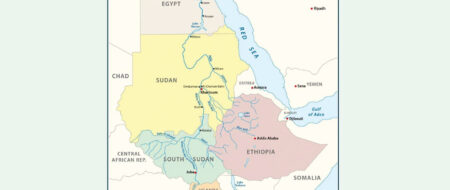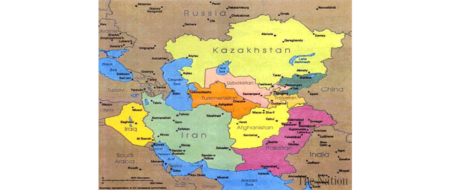Global Peace and Justice:The Christian Perspective
The Christian perspective on peace and justice broadly divides into two responses. The first links peace and justice and requires the witness to pacifism as part of the witness to justice.
Policy Perspectives, Vlm 2, No.1
The Christian perspective on peace and justice broadly divides into two responses. The first links peace and justice and requires the witness to pacifism as part of the witness to justice. This position was grounded in the ministry of Jesus Christ and shaped the early Church for the first 300 years. The second response insists that for the sake of justice and peace, it is sometimes necessary to fight. This is the position that arose after the conversion of the Roman Emperor Constantine in about 340 CE. I shall now examine each position in more detail.
Position 1: Peace and Justice are linked; The witness to pacifism is part of our witness to justice
Most New Testament scholars agree that Jesus both taught and lived pacifism. Despite the fact that he was teaching amongst a people who were occupied by a military dictatorship, many of whom were sympathetic to a potential violent revolution, Jesus calls for a life of non-violence. Jesus famously explained that:
‘You have heard that it was said, “An eye for an eye and a tooth for a tooth.” But I say to you, do not resist an evildoer. But if anyone strikes you on the right cheek, turn the other also.’
The point is that you should not exercise your entitlement to the judicial principle that you only exact a punishment equivalent to the crime (one eye for one eye). You absorb the violence instead of escalating it. The cycle of violence provoking revenge, which in turn provokes more violence, is broken by the simple act of accepting the violence.
Instead of retaliation, Jesus calls on us to forgive each other. Forgiveness is the capacity to accept the sincere repentance from another person for a past wrong and then, crucially, leaving that wrong in the past. Peter the apostle asked Jesus whether there was a limit on the number of times one is required to forgive, to which Jesus replied that there is no limit. Instead of resorting to revenge to rectify the wrong in the past, forgiveness is the mechanism that can heal the past.
It is important in Christian theology that the life of Jesus ends on the cross. This not only illustrates the principle of non-retaliation, but the crucifixion is then followed by the resurrection. This is the vindication of a life lived trusting God. Pacifism, it is important to stress, is not the capitulation to the evil; one should use every means at his disposal, short of violence, to challenge injustice and change the world. Furthermore, it is an act of trust in God who will ultimately vindicate the right and the just.
The 20th century has two famous examples of the pacifist response; both of whom were committed to both peace and justice. Mahatma Gandhi (1869-1948) in India insisted that the nationalist movement in India is not allowed to resort to violence and terrorism to achieve their ends. The occupying power (namely the British) had to be forced to leave India by a campaign of civil disobedience.
The second famous pacifist of the 20th century was Martin Luther King Junior (1929-1968). King led the civil rights movement in the United States. He explains his commitment to non-violence as the inevitable corollary of his commitment to the Christian doctrine of the Image of God:
‘Now let me say that the next thing we must be concerned about if we are to have peace on earth and good will towards men is the non-violent affirmation of the sacredness of all human life. Every man is somebody because he is a child of God. And so when we say “Thou shalt not kill,” we’re really saying that human life is too sacred to be taken on the battlefields of the world. Man is more than tiny vagary of whirling electrons or a wisp of smoke from a limitless smouldering. Man is a child of God, made in His image, and therefore must be respected as such. Until men see this everywhere, until nations see this everywhere, we will be fighting wars. One day somebody should remind us that, even though there may be political and ideological differences between us, the Vietnamese are our brothers, the Russians are our brothers, the Chinese are our brothers; and one day we’ve got to sit down together at the table of brotherhood.’
Despite enormous provocation, Martin Luther King insisted that the mechanisms of social change had to be non-violent. So the bus boycott which was triggered by Ross Parks and the campaign for voter registration were all non-violent strategies. In both cases, Gandhi and King believed their message of social change depended on not resorting to violence.
There are four arguments for pacifism. The first is the simple axiom that killing is wrong. The taking of life for any cause does not further that cause.
From this starting point, the other three points flow. The second argument is that exercising a right to violence often makes the situation worse. Military solutions to complex problems are rarely found. The English attempt to find a military solution to the terrorist attacks of the IRA in the north of Ireland did not succeed; and it does not look as if the Israeli Government is doing any better against Hamas. Sometimes in the short term, it looks as if a military solution has succeeded, only to find decades later that the original problem returns in a new guise. The Allies at the end of the First World War I imagined that the Treaty of Versailles (1919) was the solution to the problem of Germany; only to find in 1933 a key factor in the popularity of Adolf Hitler was the unpopularity of this treaty.
The third argument is that the resort to violence has a degrading impact on all. Gandhi puts this well, when he explains:
‘It is an unshakable faith with me that a cause suffers exactly to the extent that it is supported by violence. I say this in spite of appearances to the contrary. If I kill a man who obstructs me, I may experience a sense of false security. But the security will be short-lived. For I shall not have dealt with the root cause. In due course, other men will surely rise to obstruct me. My business, therefore, is not to kill the man or men who obstruct me, but to discover the cause that impels them to obstruct me and deal with it. I do not believe in armed risings. They are a remedy worse than the disease sought to be cured. They are a token of the spirit of revenge and impatience and anger. The method of violence cannot do good in the long run.’
This quotation leads into the fourth argument for pacifism. There is an obligation to solve problems at the underlying level. Violence, in the end, obscures the underlying conflict or disagreement. Often the extremist who resorts to violence does so because of an underlying insecurity. The ‘white supremacist’, who wants to lynch blacks, and the homophobic, who wants to persecute gays, are expressing their cultural and personal insecurity by lashing out in hatred and dislike of others. To fight this violence with violence only exacerbates the insecurities; however, to fight this violence with love can be a way of transforming the damage that underlies the insecurities.
Pacifism is a vision: it is a potential way of life. It does assume that love can triumph and, in the end, bad people can and will be changed. Could a Gandhi or a Martin Luther King have defeated Hitler in Germany? This is less clear. And it is for this reason that many Christians argue that there are occasions when the resort to killing is necessary. Naturally there must be rules. When two nations fight, the armies determine the result. The killing of children (or more broadly – non-combatant civilians) does not help the result of the war at all. These rules are now part of International Law, recognized by the vast majority of nations in the world, as legitimate rules for combat. These rules are the second position, which we shall turn to next.
Position two: For the sake of Justice and Peace, it is sometimes necessary to fight
We have already seen that Jesus lived and died a pacifist. Even though the Romans were occupying Palestine, Jesus consciously rejected the option of violence. When Jesus was arrested outside in Gethsemane, Matthew’s Gospel reports that one of his disciples tried to defend him with a sword. Matthew writes:
‘Suddenly, one of those with Jesus put his hand on his sword, drew it, and struck the slave of the high priest, cutting off his ear. Then Jesus said to him, put your sword back into its place; for all who take the sword will perish by the sword. Do you think that I cannot appeal to my Father, and he will at once send me more than twelve legions of angels? But how then would the scriptures be fulfilled, which say it must happen in this way?’
Historians agree that Jesus did not only teach pacifism, but was willing to die for his pacifist principles. The conscious rejection of pacifism continued to shape the early church for the first 300 years of its existence. It was not until the conversion of the Roman Emperor Constantine (c.340 CE) that Christianity started to try and find ways of justifying war. It was the Bishop of Hippo, St. Augustine (354-430) who planted the seeds of Just War Tradition. His immediate problem arose in 410 CE when Rome was facing defeat at the hands of the Visigoths and neighbouring tribes. Part of the Empire’s vulnerability was due to the reluctance of Christians to defend the Empire. Augustine found in the Hebrew Bible ample justification for war (see Exodus. 15:1-18, Deut. 20:10-18, Joshua 6-7). As God was willing to command war, and as God is responsible for appointing the rulers of nations, then surely war, under certain circumstances, can be justified.
Augustine suggested two conditions. The first was the war had to be authorized by a legitimate authority. Under no circumstances can the action of vigilantes be justified: individuals taking the law into their own hands can often lead to the cycle of violence – killing giving birth to revenge. Given he believed that God was responsible for the appointment of the rulers of the nation, then the legitimate authority was the God appointed ruler. The second was that there must be a just cause. This can include self-defence or the protection of others. But it cannot include the expansionist ambitions of a particular ruler.
In the 13th century, the great Dominican Friar St. Thomas Aquinas, whom we met in an earlier chapter on Natural Law, added a third condition. There has to be a right intention. You must intend to promote good not evil. In one sense this condition was clarifying the second condition – the cause must be just. Underpinning the clarification of Aquinas, we have the insight that the goal of waging war is to create a just peace. Aquinas believed that sometimes the way to arrive at a just peace is to wage war against the unjust ruler. The sort of picture emerging is that we are justified in occasionally resorting to war, if and only if, it is the only possible route to a just peace.
The Just War tradition continued to grow and develop. In the 16th century, two Spaniards, Vitoria and Suarez, are responsible for developing the tradition and explicitly talking about ‘international law’. Franciso de Vitoria (1492-1546) is universally acclaimed as the founder of modem international law. He was a Dominican and for much of his career taught at the University of Salamanca. Two years after Vitoria’s death, Francisco Suarez (1548-1617) was born. His extensive writings in theology (especially ecclesiology) and ethics (especially politics) made him extremely prominent. Between Vitoria and Suarez three further conditions were added to the Just War tradition.
The first was that all other means of rectifying the injustice have failed. War really must be the last resort. All peaceful means must have been tried to rectify the wrong that has been done. The second was that there must be a reasonable hope of winning the war. Now this is an interesting condition: the tradition does teach that it is wrong for a ruler to lead a nation into an heroic fight, even if the cause is just, where there is certain defeat. Futile just wars are not commended. The point, of course, is that the tragedy of the many potential deaths always needs to be weighed heavily in the scales before embarking on the action. The third was that the manner of conducting the war must be legitimate.
The presumption is that needless killing is always wrong. Death and misery must be kept to the minimum necessary to create a just peace. So, for example, Vitoria did think that taking from those you conquer their weapons was legitimate, but despoiling their agricultural crops was wrong. Given many recent wars (e.g. the Bosnia-Herzegovina war) have involved the victors raping and burning the homes of the losers, leading to a considerable refugee problem, Vitoria had a moral insight here that the world still needs to learn.
As we enter the 21st century, the Just War Tradition remains as relevant as ever. To summarize the journey of the Just War tradition thus far, we find that we now distinguish between the appropriate conditions for waging war (jus ad bellum) and the moral conduct once involved in war (jus in bello). Almost anyone who feels that occasionally war is legitimate will affirm that the Just War tradition is important. And the modern contemporary arguments are over three areas: first, is it possible to have a ‘just revolution’? Second, can one ever use a nuclear weapon within a modem war? And if, ethically, one cannot use them, then in what sense are such weapons a deterrent? And third, in a world where the biggest fear is that a terrorist group may obtain access to a weapon of mass destruction, do we need to modify this tradition to permit ‘pre-emptive’ warfare? Let us now list the Just War criteria and explore these three issues.
The conditions for the waging war (jus ad bellum) are as follows:
- The need for a legitimate authority: Although some have argued that a ‘just revolution’ ought to be an option against an unjust ruler, the tradition wants to confine legitimate authority to the government. The problem with private individuals and groups is that violent action can easily merge into the world of gang warfare and the vigilante. Linked with this, there is a sense in which the vocation of leadership of a nation involves the responsibility of deciding when it is necessary to take up arms for a just cause. The leader is in a position to see the big picture and therefore best able to make the call that violence is necessary.
- The cause must be just: The problem in practice with this condition is the extent of one’s memory. The tradition wants to confine war to self-defence, a defence of another nation, the protection of innocents, or to regain which should not have been taken. However, many battles (e.g. the wars between Serbia and Croatia) have complex historical roots. The question whether a just cause extends to a pre-emptive war is difficult to answer. As a general rule, the tradition requires that an evil deed needs to have been committed. The problem with anticipating an evil deed is that one is never sure that the deed will have been committed; it is therefore easy to be unjust.
- The third condition is right intention: War must be fought with the goal of creating a just peace.
- War must be the last resort: It is always a serious matter to embark on war. War dead are an inevitability. Indeed such is the ‘science’ of war today, it is possible to estimate the numbers of dead (both combatants and non-combatants). Therefore, given the seriousness of war, the government must have exhausted all other diplomatic and non-military means for securing peace and justice. This is a key difficulty for anyone arguing for a pre-emptive war: it will inevitably seem that war has been chosen before all the other options have been exhausted.
- A reasonable chance of success: We are living in an interesting historical moment. With only one superpower, it is clear that the government of the United States will always meet this condition. With its vast military might, the United States can secure a result within months of starting a conflict. The ambiguity here, however, is whether that is a sufficient definition of success. Establishing the subsequent peace is extremely difficult.
- Proportionality is an important aspect to the military response: When the Government of Argentina invaded the British ruled Falklands (1982), then it would have been a violation of this condition of a Just War for the United Kingdom to have used nuclear weapons against the major cities of Argentina. The response to an injustice must not create even more injustice. This condition poses significant difficulties for both the use of nuclear weapons and the concept of a pre-emptive war.’ Conditions applying to the conduct of the war (jus in hello).
- It is wrong to target non-combatants: The major victims of a war are often the elderly, women, and children. These people are not in a position to determine the results of the battle. So the death and injury of a non-combatant is wrong. This again is a key difficulty with nuclear weapons. However, it is important to note that the latest generation of weapons is capable of being targeted very effectively. It is worth noting that the tradition does recognize that ‘collateral damage’ will occur (i.e. there are moments when tragically a non-combatant is hit).
- It is necessary to use proportionate means: Proportionality is both an issue before one embarks on the war and during the war. Use of a nuclear weapon is almost always problematic. Whether, for example, the destruction of Hiroshima (let alone Nagasaki) met this condition remains one of the most contentious issues surrounding the conduct of World War II. Those who thought it legitimate argue that these two bombs ensured an earlier surrender of the Japanese to the Allies; those who think this illegitimate just point to the millions of non-combatants who were killed.
Implications for Global Peace and Justice
Christians believe that it is important that all alternatives to violence and war have been exhausted. Even in the Just War tradition, violence must be the last resort and invoked exclusively for the goal of a just peace.
The question obviously arises: what is a just society from the perspective of Christians? The following are the main components. First, there is a recognition of the fundamental human rights of all people. Human rights has it roots in post-Enlightenment thought. John Locke (1632-1704) is a key person and the French Revolution is a key occasion. However, the Enlightenment formulation of the concept should not obscure the deeper Christian and religious roots of the entire discourse. The doctrine that all people are made in the Image of God is a key idea here. Indeed I hold that without a religious framework the discourse is difficult to sustain.
Second, a just society must provide an equality of opportunity. The moral status of all people is equal. And the opportunities of all people to succeed must also be equal. The greatest challenge to the development world is inclusion. It is so easy to overlook the marginalized and poor, whose choices are so limited by the lack of education or framework of social support. A just society is obligated to ensure that they are included.
Third, a just society must have a strong framework for law and order. This is a fundamental condition for a fair and healthy society. People are entitled to live lives unhindered by theft and attacks.
Fourth, a just support provides an effective range of welfare support. Inevitably there are people who are going to struggle. A just society must make some provision to ensure that they survive.
Christians are called by God, who is revealed in Jesus Christ, to create this just society. The challenge to all Christians is to play our part in bringing closer the society that God always entitled through a constructive engagement with all people.
The result is the most dynamic and the most exploitative system of production and consumption the world has ever experienced. The Imperial reach of the dominant country has no boundaries.
Mathew; 5:389. New Revised Standard Version, “Ye have heard that it hath been said, An eye for an eye, and a tooth for a tooth:”
(9) He shows that contrary to the doctrine of the scribes, that the sum of the second table must be so understood, that we may in no wise render evil for evil, but rather suffer double injury, and do well to them that are our deadly enemies.
Martin Luther King, ‘Christmas Sermon 1967’ from James Melvin Washington (ed.) A Testament of Hope: The Essential Writings of Martin Luther King, Jr. (San Francisco: Harper and Row, 1986)
Gandhi, Mahatma. “The Mind of Mahatma Gandhi.” Welcome To The Complete Site On Mahatma Gandhi. www.mkgandhi.org. Nov. 20, 2004











